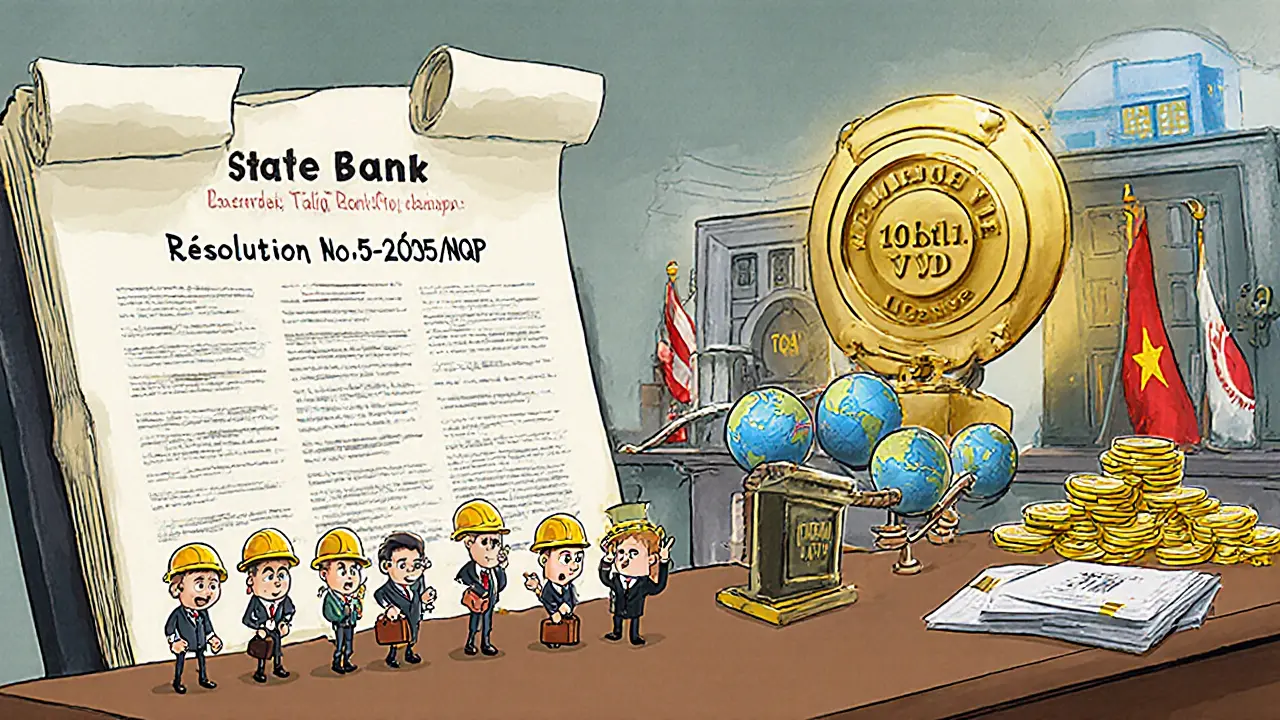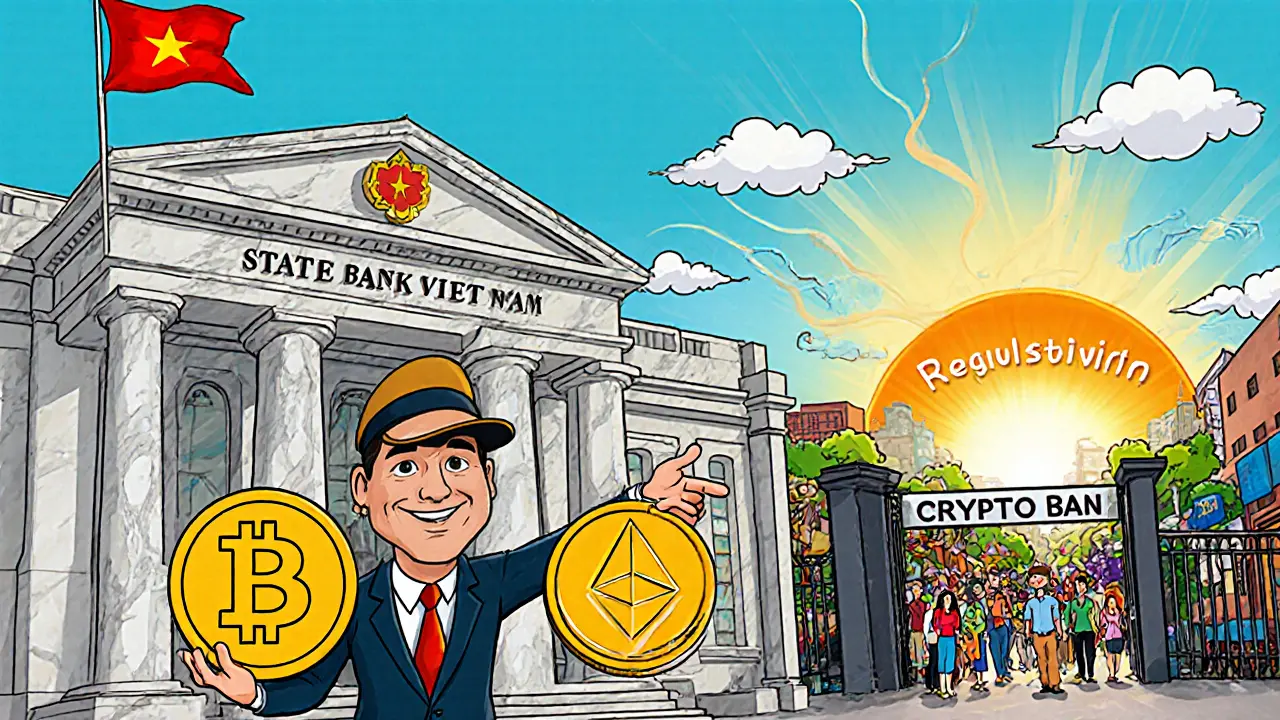Vietnam Crypto Policy 2025: Exchange Licensing Calculator
The State Bank of Vietnam's Resolution No. 05/2025/NQ-CP sets strict licensing criteria for cryptocurrency exchanges. Use this calculator to understand the key requirements and compare them to neighboring countries.
| Aspect | Vietnam | Singapore | Philippines |
|---|---|---|---|
| Legal status of BTC/ETH | Legal virtual assets (payment prohibited) | Legal and regulated | Legal, regulated under AML laws |
| Stablecoin policy | Fiat-backed stablecoins restricted | Broadly permitted with licensing | Allowed with registration |
| Exchange licensing capital | 10 trillion VND (~$379 million) | S$1 million (~$750k) | Php 5 billion (~$90k) |
| Number of licensed exchanges (pilot) | 5 (pilot) | ~30 (full market) | ~12 (full market) |
| Foreign investor access | Via approved CASPs only | Direct participation allowed | Direct participation allowed |
*Note: Values are approximate and based on 2025 exchange rates.
Key Insight
Vietnam's capital requirement of 10 trillion VND (~$379 million) is among the highest in Asia. This reflects the State Bank's cautious approach to ensure financial stability and robust compliance measures.
State Bank of Vietnam is the central bank of Vietnam that oversees monetary policy, financial stability and, as of 2025, the country’s cryptocurrency framework has taken a dramatic turn this year. After years of outright bans, the bank now backs a regulated market for digital assets, aiming to capture economic benefits while keeping a tight grip on risk. If you’re wondering how this shift plays out, what it means for exchanges, investors, and the broader economy, keep reading - the details are worth the dive.
Quick Takeaways
- Vietnam legalized crypto assets in June 2025 under the Law on Digital Technology Industry.
- Resolution No.05/2025/NQ-CP creates a five‑year pilot licensing regime for exchanges.
- Licensing caps capital at 10trillion VND and limits trading pairs to the Vietnamese dong.
- Only five exchanges can operate; foreign investors must use approved Crypto Asset Service Providers (CASPs).
- The government launched NDAChain, a permissioned blockchain for tokenizing bonds, carbon credits and more.
From Prohibition to Legalization: The 2025 Turnaround
Up until early 2025, the State Bank of Vietnam treated crypto as a prohibited payment method and barred banks from processing related transactions. The June 2025 amendment to the Law on Digital Technology Industry flipped that stance, formally recognizing Bitcoin (BTC) and Ethereum (ETH) as “virtual assets.” This change was driven by Deputy Governor Pham Thanh Ha who argued that regulated digital assets could boost credit growth and tax revenues. While crypto can now be owned, transferred, inherited and protected under Vietnamese law, using it for everyday payments remains illegal.
Resolution No.05/2025/NQ-CP: The Licensing Blueprint
The cornerstone of the new regime is Resolution No.05/2025/NQ-CP issued on 9September2025, it establishes Vietnam’s first formal licensing framework for cryptocurrency exchanges. The resolution defines crypto assets as digital items secured by encryption, explicitly excluding securities and digital fiat. It also mandates a five‑year pilot, during which only five domestic exchanges may receive licenses.
Key licensing criteria include:
- Minimum paid‑in capital of 10trillion Vietnamese dong (≈$379million).
- At least two capital partners drawn from banks, securities firms, insurers, fund managers or tech companies.
- Each partner must show two consecutive years of profitability before applying.
- All trading must be quoted in Vietnamese dong; no foreign‑currency pairs are allowed.
- Foreign investors can only access the market through Ministry of Finance‑approved Crypto Asset Service Providers (CASPs) entities that act as intermediaries for overseas capital.

Capital Requirements and Exchange Operations
The 10trillion VND capital floor is one of the toughest in the region. By comparison, Singapore’s Monetary Authority of Singapore (MAS) requires a minimum of S$1million for a digital asset services licence. Vietnam’s high bar reflects the State Bank’s caution: the bank wants only financially strong players that can absorb market shocks and comply with rigorous AML/KYC standards.
Because of these requirements, no firm has yet submitted a formal licence application as of October 2025. Industry insiders suspect that potential partners are still weighing the cost‑benefit balance, especially given the heavy compliance burden and the restriction to dong‑only trading pairs.
How Vietnam Stacks Up Against Its Neighbors
| Aspect | Vietnam | Singapore | Philippines |
|---|---|---|---|
| Legal status of BTC/ETH | Legal virtual assets (payment prohibited) | Legal and regulated | Legal, regulated under AML laws |
| Stablecoin policy | Fiat‑backed stablecoins restricted | Broadly permitted with licensing | Allowed with registration |
| Exchange licensing capital | 10trillion VND (~$379M) | S$1million (~$750k) | Php5billion (~$90k) |
| Number of licensed exchanges (pilot) | 5 (pilot) | ~30 (full market) | ~12 (full market) |
| Foreign investor access | Via approved CASPs only | Direct participation allowed | Direct participation allowed |
Vietnam’s approach is undeniably stricter. While this may dampen rapid institutional growth, the country’s high retail enthusiasm-over 20% of tech‑savvy citizens own crypto-keeps the market vibrant in the informal sector.
NDAChain: Vietnam’s Home‑grown Blockchain Network
Beyond exchange regulation, the State Bank backs a national blockchain platform called NDAChain a permissioned blockchain launched in July2025 for tokenizing bonds, carbon credits and other assets. NDAChain is intended to give the government visibility into tokenized transactions while offering a secure environment for enterprises to experiment with blockchain technology.
Key features of NDAChain include:
- Permissioned consensus that limits node participation to vetted institutions.
- Built‑in privacy layers to protect personal data.
- Smart‑contract support for automated settlement of tokenized securities.
- Interoperability bridges to public chains, enabling limited cross‑chain asset movement under state supervision.
The platform reflects Vietnam’s desire to harness blockchain benefits-efficiency, transparency, new financing models-without surrendering regulatory oversight.

Economic Impact: Growth, Credit, and Tax Revenue
Deputy Governor Pham Thanh Ha has linked the regulated crypto market to a projected 20% credit growth for 2025. The logic is straightforward: a legal trading venue attracts capital, spurs fintech innovation, and creates taxable events. Early estimates suggest that the pilot could generate up to VND200billion in tax revenue annually, mainly from transaction fees and capital gains.
Furthermore, the State Bank envisions crypto assets being used in traditional financial products. Insurance firms are already piloting Bitcoin‑linked policies, while pension funds are studying tokenized asset exposure. If these use cases scale, they could diversify investment portfolios and improve liquidity.
Implementation Challenges and Outlook
Despite the ambitious framework, real‑world rollout faces hurdles:
- Zero licence applications: The steep capital requirement remains a disincentive for most domestic firms.
- Compliance burden: Continuous AML/KYC monitoring, reporting in dong, and audit requirements demand sophisticated back‑office systems.
- Informal market pressure: Peer‑to‑peer platforms like Binance P2P continue to thrive, potentially undermining the regulated pilot’s market share.
- Regulatory fine‑tuning: The five‑year pilot allows for adjustments, but frequent policy shifts could erode investor confidence.
Looking ahead, the State Bank has signaled willingness to revisit capital thresholds and expand the number of licensed exchanges if the pilot proves successful. A gradual easing could position Vietnam as a balanced hub-strict enough to protect stability, flexible enough to attract quality investment.
Key Takeaways for Market Participants
If you’re a crypto business eyeing Vietnam, here’s what you need to act on now:
- Start building relationships with Vietnamese banks, insurers or tech firms that could satisfy the two‑partner capital rule.
- Design all trading interfaces to quote exclusively in Vietnamese dong.
- Prepare AML/KYC processes that meet the State Bank’s documentation standards.
- Explore partnerships with approved CASPs for any foreign‑investor exposure.
- Monitor the pilot’s performance metrics-transaction volume, compliance violations, tax receipts-to gauge when regulatory flexibility might increase.
Frequently Asked Questions
Is cryptocurrency legal to use for payments in Vietnam?
No. While Bitcoin and Ethereum are recognized as legal virtual assets that can be owned and transferred, using them as a means of payment remains prohibited by the State Bank of Vietnam.
What is the capital requirement for a crypto exchange licence?
Applicants must have at least 10trillion Vietnamese dong (about $379million) in paid‑in capital, contributed by at least two qualified financial or tech entities.
Can foreign investors trade directly on Vietnamese exchanges?
Foreign investors must go through Ministry of Finance‑approved Crypto Asset Service Providers (CASPs); they cannot open accounts on the domestic exchanges directly.
What is NDAChain and who can use it?
NDAChain is a permissioned national blockchain launched by the State Bank. It is open to vetted Vietnamese institutions for tokenizing bonds, carbon credits and other assets, while the central bank retains oversight.
How does the new policy affect tax obligations?
Transactions on licensed platforms are subject to standard corporate tax and capital gains tax. The government expects the regulated market to generate significant tax revenue, estimated at VND200billion per year.

Vietnam's new crypto licensing framework is a bold step toward formalizing a market that has been thriving in the shadows. The 10 trillion VND capital floor sends a clear signal that only well‑capitalized players will be allowed to operate. This should help mitigate systemic risk while still giving local entrepreneurs a chance to get involved. For retail investors, the continued prohibition on using crypto for payments keeps the everyday use case limited, but the mere legality of ownership is a win. Overall, the policy balances innovation with prudence.
The State Bank of Vietnam's Resolution No. 05/2025/NQ‑CP is a watershed moment that reshapes the entire regional crypto landscape, and its implications ripple far beyond the borders of Southeast Asia. By instituting a 10 trillion VND (approximately $379 million) paid‑in capital requirement, the regulator has set a bar that dwarfs the capital thresholds of neighboring jurisdictions such as Singapore and the Philippines, thereby creating a high‑entry barrier that favors only the most financially robust institutions. This move is evidently designed to protect the domestic financial system from the volatility that has plagued many emerging markets, as well as to ensure that any licensed exchange can sustain rigorous AML/KYC compliance demands without compromising operational stability. Moreover, the requirement that at least two partners be drawn from banks, securities firms, insurers, fund managers, or technology companies ensures that the exchange ecosystem will be underpinned by established financial expertise, which should enhance investor confidence and foster a culture of due diligence. The restriction to VND‑only trading pairs eliminates the foreign‑exchange risk that can exacerbate price swings during periods of market stress, aligning with the central bank's broader goal of financial stability. While the capital hurdle is undeniably steep, the pilot program’s limited licence count-only five exchanges-means that market participants will likely compete fiercely to secure a spot, potentially driving innovation in cost‑efficient compliance solutions. Foreign investors are not excluded outright; they can gain market access via Ministry‑approved Crypto Asset Service Providers (CASPs), a compromise that maintains sovereign control while still attracting overseas capital. The CASP model also offers a regulatory checkpoint, ensuring that foreign funds are funneled through vetted channels that adhere to Vietnamese law. Additionally, the introduction of NDAChain, a permissioned blockchain for tokenizing bonds and carbon credits, signals the State Bank's intention to harness distributed ledger technology for broader financial applications, not just crypto trading. By providing a sandbox for tokenized assets, Vietnam positions itself to capture the efficiency gains of blockchain while retaining oversight through permissioned node participation. On the fiscal side, the government projects that the regulated market could generate upwards of VND 200 billion in tax revenue annually, a figure that underscores the potential macro‑economic benefits of formalization. However, the high capital threshold may also dissuade smaller, innovative firms from entering the market, potentially leading to a concentration of power among a few large players. The success of the pilot will ultimately hinge on the regulator’s willingness to adjust the capital requirement and expand the number of licences if the initial rollout demonstrates stability and compliance. In summary, Vietnam’s policy is a calculated blend of strict capital controls, limited market access, and forward‑looking blockchain initiatives designed to safeguard the financial system while still tapping into the growth potential of digital assets.
Wow, that capital req is a monster!!
I can see how the high capital bar might protect investors, but it also feels like a roadblock for startups.
It’ll be interesting to watch how the market evolves under these constraints.
The VND‑only trading rule simplifies AML monitoring by removing cross‑currency complexities.
Nevertheless, it limits arbitrage opportunities that could otherwise increase liquidity.
Regulators will need to balance these effects as the pilot progresses.
From a cultural perspective, Vietnam’s cautious approach reflects a broader regional skepticism toward unregulated fintech.
Yet, the country’s tech‑savvy youth are already well‑versed in crypto, which could fuel a vibrant underground market.
By providing a legal avenue, the State Bank may gradually migrate that energy into the formal sector.
The partnership requirement with established financial entities also encourages knowledge transfer and capacity building.
Overall, the policy walks a fine line between control and innovation.
For anyone looking to enter the Vietnamese market, start building relationships with local banks and insurers now.
Those partnerships will be crucial to meet the two‑partner rule.
Also, make sure your AML/KYC stack can handle the local regulatory demands.
Patience will be key; the licensing process may take time.
They’re probably putting a secret backdoor in NDAChain for the government to watch every transaction.
Don’t trust any of this until it’s fully transparent.
That capital requirement is insane.
The licensing framework introduces a de‑facto KYC‑as‑a‑service model, which will pressure technology providers to integrate advanced identity verification APIs.
Additionally, the mandated VND‑only pairs will necessitate robust FX hedging solutions for any cross‑border liquidity providers.
Expect a surge in demand for compliant on‑chain analytics tools tailored to Vietnamese regulatory criteria.
One might argue, perhaps, that this regulatory edifice, while ostensibly protective, could also be construed as a strategic maneuver to consolidate economic power within a select cadre of oligarchic entities; yet, the counter‑argument remains that such consolidation may, paradoxically, stifle the very innovation the policy purports to nurture.
Furthermore, the sheer scale of the capital requirement introduces a formidable barrier to entry, which, in turn, may engender a monopolistic environment, thereby curtailing competition.
Nevertheless, the State Bank's emphasis on AML/KYC compliance could be viewed as a proactive safeguard against illicit financial flows.
In any case, the long‑term efficacy of this approach will ultimately be determined by how adaptable the regulatory framework proves to be in the face of rapid technological evolution.
In response to the extensive analysis presented, it is evident that the capital threshold serves both as a protective measure and as a filter for serious market participants.
While the stringent requirement may deter smaller innovators, it simultaneously assures the regulator of the financial resilience of licensed exchanges.
The inclusion of CASPs for foreign investors offers a pragmatic compromise, preserving capital inflows without compromising oversight.
Overall, the policy reflects a measured attempt to balance stability with growth potential.
Building upon the previous point, the formal tone of the regulatory language underscores the State Bank’s commitment to institutional integrity.
Such formality may also reassure international partners about Vietnam’s dedication to compliance standards.
Nevertheless, flexibility in future amendments will be crucial to avoid stifling emergent fintech solutions.
Continuous dialogue between regulators and industry stakeholders will be the linchpin of sustainable progress.
I’m curious about how the limited number of licences will affect market liquidity.
Will the five pilot exchanges be enough to meet demand?
Only time will tell as the ecosystem evolves.
Honestly, this is just a way for the government to control the money supply and keep the power hoarded by the elite.
They’ll never let a real, decentralized system thrive under these shackles.
Wake up, people!
Sure, the policy looks protective, but it also screams ‘protect our own interests first.’
Why not open the market fully and let competition drive innovation?
Looks like a classic case of regulatory capture.
Regulation is fine as long as it doesn’t stifle freedom 😤🚀.
Let’s hope they keep it balanced!
i think the gov is overreactin.
too much money req for small biz.
The vibrant crypto community in Vietnam could benefit from a more inclusive approach.
Colorful partnerships between tech startups and traditional finance might spark fresh ideas.
Let’s keep an eye on how the pilot unfolds.
It’s easy to see the State Bank’s policy as a protective wall, but there’s a hidden agenda: consolidating financial power under the guise of stability. The astronomical capital requirement isn’t just a financial safeguard; it’s a gatekeeper that filters out the innovative underdogs who could disrupt the status quo. By limiting the number of licences to a mere five, the regulator ensures that only the most politically connected entities get a foot in the door. This selective licensing process may also serve to channel crypto activity through state‑approved CASPs, effectively giving the government a chokehold on foreign capital. Moreover, the prohibition on crypto payments keeps everyday usage underground, preserving the illusion of compliance while the real market thrives in the shadows. The NDAChain initiative, touted as a forward‑thinking blockchain, could double as a surveillance tool, granting authorities unprecedented visibility into tokenized transactions. While the policy claims to protect investors, it simultaneously creates barriers that hamper competition and stifle genuine innovation. In the long run, such heavy‑handed regulation may drive talent and capital to more crypto‑friendly jurisdictions. Only a transparent, adaptable framework can truly harness the benefits of digital assets without sacrificing sovereign oversight.
Dang, the policy feels like a double‑edged sword-great for stability but brutal for the little guys.
Hope the regulators listen to community feedback.
Otherwise we’ll see a surge in covert P2P trades.
The capital hurdle is massive; it will undoubtedly shape market dynamics.
Only large, well‑funded players will survive the licensing process.
Excited to see how this pilot evolves-maybe it’ll pave the way for a balanced crypto ecosystem! 😊
Let’s stay optimistic and supportive.